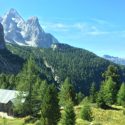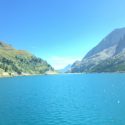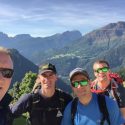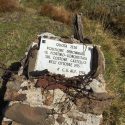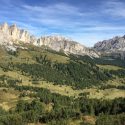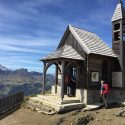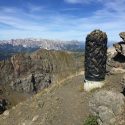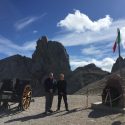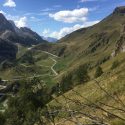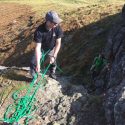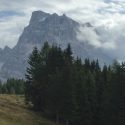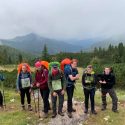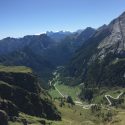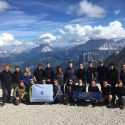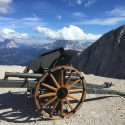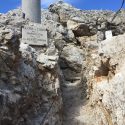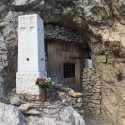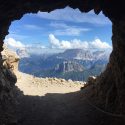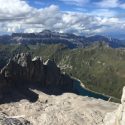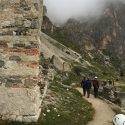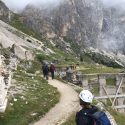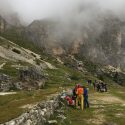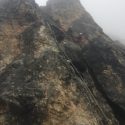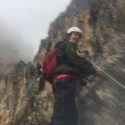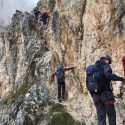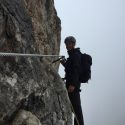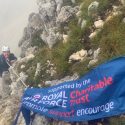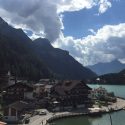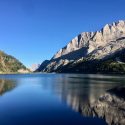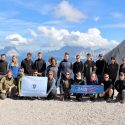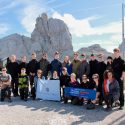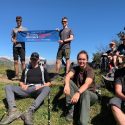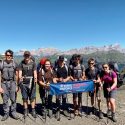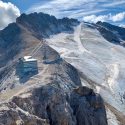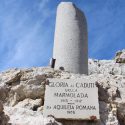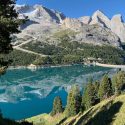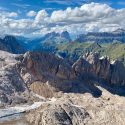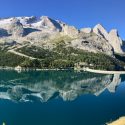Between the 31 Aug and 08 Sep 22 cadets and 8 staff from Sussex and Hants / Isle of Wight Wing undertook an expedition to the Italian Dolomites thanks to generous support from the Ulysses Trust and RAF Charitable Trust. The main thrust of the expedition was a four day trek linking a number of WW1 Military sites from the Austrian / Italian battles which met the requirements of a Gold Assessed Expedition for the Duke of Edinburgh’s Award with a really interesting and military orientated aim.
The trek also sadly has become known as the Ted Atkins Memorial Walk in memory of famed RAF climber and Everest Guide Flt Lt Ted Atkins who had fallen to his death on Civetta, in the area, a year to the day before whilst leading a via feratta walk with clients – he had been working on the project using local knowledge with the expedition leader Flt Lt Dave Hill at the time.
The cadets were divided into three teams following essentially the same route starting from a museum at Piz Ciampei near the Valparola Pass. Day 1 was wet and with a threat of thunderstorms as the teams took off, the aim being the Col Di Lana, the highest peak of the trek at 2520m asl, where there were numerous memorials, a church, caves with armaments still present and lots of evidence of battles. The teams faced strong winds and rain once up on the main ridge and had to take refuge in a mountain refuge to let a thunderstorm pass before descending into Pia di Livianlongo. The descent was made tricky in that large sections of the route down were still blocked by fallen trees from a cyclone that hit the area in Oct 2018 (post the staff recce) causing massive devastation to roads paths and infrastructure.
Day 2 was a more sedate walk contouring the Val de Davedin to a wild campsite on the north bank of the Lago di Fedaia, however again the final climb over the El Jof pass was made difficult by more fallen trees. All along the route was evidence of caves being turned into machine gun or artillery posts, including an abandoned field gun. The weather this day was the best of the trip and afforded some amazing views
Day three meant climbing back up to El Jof pass but by a less well made path north of the Lake to go via the main Gondola at Piasso Paddon. En route a number of outposts were spotted built into the rock and seemed to offer slightly more comfortable space, possibly for longer stays however on reaching the Sass di Roi pass it became necessary to move onto an alternative route as the main path had been wiped out by a landslide so the teams had to descend carefully down to the main road and then pick a route the main ski areas to the campsite at Malga Ciapela, underneath the mighty Marmolada.
Day 4 was a more sensible contoring path following a gorge all the way to Caprille but here it was very obvious the damage the cyclone and subsequently flooding had caused in the area with large sections of the river bank damaged and debris still everywhere. On returning to the campsite at the foot of Marmolada the teams took the gondola up onto the top of the Marmolada (3200m asl) where as well as being afforded some amazing views they were able to visit the museum and the network of “ice caves”, natural caves in the rocks that were converted into military posts – it really struck the team how cold it was with the glacier next door and this was early September so it must have been unbearable in the height of winter with minimal kit and supplies.
The next day was supposed to be a visit the Ted’s memorial plaque but the decision was taken that the weather conditions were unsafe to do so instead Teds wife and son hosted the teams at their house, including a tour of the house which was built by a famous Italian painter – however in true Ted fashion the teams were met with the surprise on arrival of moving 75 x 20kg bags of wood pellets from the road up a long steep path to the house, fuel for the winter ahead, but were rewarded with hot drinks, cake and quiche for their efforts.
The final day was a moderate Via Ferratta climb back at Valparola Pass. The technique was developed by the Italians to flank the Austrian troops and although much of the original iron wire has been replaced for safety evidence still existed of the original routes put in by hand by the soldiers. In places the route was more of a rock climb than a scramble and sadly the teams had to pull off short of the top as rain turned through hail into snow making the climb dangerous. It did give however a unique insight into the technique and also passed the ruins of a WW1 Military Hospital high on the route as this was a significant point to hold during the battles.
An amazing insight into a little publicised aspect of WW1 where the troops from both sides must have endured considerable hardships as well as the pressures and risks of being in a battle zone. It goes without saying that all three teams successfully completed the trek, meeting the conditions for their Gold award and are now completing the other sections with a view visiting the Palace to collect their Gold awards soon!!!!
The Ulysses Trust also wish to thank the generosity of the Royal Air Force Charitable Trust for supporting this expedition. www.rafct.com

